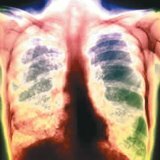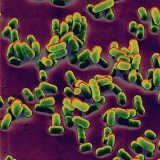Ebola fever
 Ebola fever has claimed thousands of lives. Today it is told in the news and written in the media. It spreads around the world, but doctors have not yet created a vaccine against it. In this article, you will learn more about this disease.
Ebola fever has claimed thousands of lives. Today it is told in the news and written in the media. It spreads around the world, but doctors have not yet created a vaccine against it. In this article, you will learn more about this disease.
What is Ebola fever?
Many doctors call this fever "Ebola haemorrhagic fever".The disease is caused by the Ebola virus, therefore, combining the first letters of the term, the doctors gave a short name to BVVE.It is a viral infection that affects the internal organs of a person. Everything happens under the influence of DIC-syndrome.
For those who do not know what the DIC-syndrome is, we will explain. So shortened the doctors call disseminated intravascular coagulation. When Ebola fever occurs in the tissues of an infected person, intravital necrosis begins to occur. As a result, it turns out that a person is alive, but his organs are affected and begin to die inside - their decay and decomposition begins. During such processes, a large amount of toxic substances are released in the body, which lead to severe intoxication. The destruction of all structural units of blood begins. This also applies to platelets, which are responsible for clotting of blood.
If a virus does not coagulate, this leads to severe internal bleeding. That is why the fever of Ebola is called hemorrhagic fever. Out of ten infected, only half of the people survive.
For the first time outbreaks of the virus were recorded in 1976 in a small village that was located near the Ebola river basin. Hence the name went. Features of the Ebola virus are as follows:
- Severe course of the disease with a lethal outcome.
- Flashes happen spontaneously near wet tropical forests.
- The virus can be transmitted to humans from animals( rodents, monkeys, birds).Then the sick person in contact with other people infects them.
- The victim of the virus must be provided with urgent medical assistance, otherwise the person will die.
For the first time people faced this fever in Sudan and Zaire, then the virus took hundreds of lives of people of these countries. The epidemic ended as quickly as it began, so doctors did not do a vaccine against it. Then in 1980, a virus infected a Frenchman who visited Kenya. When he was hospitalized, an incorrect diagnosis was made and the virus was passed on to the treating doctor. After the death of a doctor, he took samples of tissues and blood for examination. Then the Ebola virus was revealed.
Since then, several outbreaks of the virus have been observed in different countries: In Liberia, Uganda, Congo, Guinea. Thus, the virus for a long time did not leave the territory of Africa. However, in 2014, new outbreaks of the virus began around the world in the spring, which caused panic and horror. Over the past six months, the virus has been seen in Nigeria, Mali, Liberia, Sierra Leone and other countries.
Doctors have installed several types of virus, but they are still not fully understood. Outside, the membrane membrane of the virus has spine-like growths. Inside the structure there are seven protein molecules, but at this stage of the study of the virus it was possible to establish the appointment of only three of them.
The virus instantly affects the immune system. Cases of infection occur through contact of an infected person with a person or from an infected animal to a person. Many people have become infected when eating meat from sick animals. The virus can penetrate through small wounds, in contact with blood and biofluids. You can get infected and in contact with medical instruments, household items, linens, through the sputum of a sick person, through contact with the body of a deceased infected person.
The virus is transmitted by airborne droplets. Therefore, any contact with a sick person a healthy person can get from him. Today, doctors manage to fight the virus. However, even after clinical infection, a person should remain in quarantine for 50 days.
Symptoms of Ebola Fever
The incubation period from the onset of symptoms should last for up to three weeks. The disease begins to manifest itself with pain in the throat, body aches, and a rise in temperature. Then there is weakness and headache, diarrhea and vomiting, dehydration of the body. Over time, a person begins to notice a dry cough and pain in the thoracic area. Further, there is a hemorrhagic rash on the body, which is similar to a rash in measles or scarlet fever. At the last stage, multiple hemorrhages begin: internal and external.
What happens in the body of an infected person
The virus is very cunning. Penetrating into the body, it deceives our immune system. He exposes on the surface of his cells a molecule that is very similar to a molecule of folic acid. Therefore, disguised as a vitamin, the virus penetrates into the genome of cells and begins to multiply rapidly there. The virus attacks respiratory organs, liver cell structures, blood vessels. Thrombi and clots begin to fill the blood system quickly and blood gets worse to tissues and organs.
In the second stage, the blood can no longer curl up and as a result, bleeding begins from the nose, the vagina, the gastrointestinal tract, the eyes, the gums, and the wound. Bleeding is formed and inside organs, mucous membranes. Subcutaneous fat begins to die and cracks form on the skin, from which the blood oozes. The language becomes purplish red. Mucous membranes of internal organs begin to flake off.
In cases of brain tissue damage, epileptic seizures occur in a person, in which blood can splash around and get on healthy people, increasing the risk of their infection. The body inside is decomposed and filled with toxic substances, resulting in death.
The severity of the course of the disease and the death rate directly depends on the type of the virus.
How the disease is diagnosed
If there is a suspicion of a virus infection, the patient is hospitalized for quarantine. The doctors take blood, liquids and tissue samples from him for analysis. In laboratory special conditions, special equipment is used to conduct a study. Antibodies, antigens of the virus, RT - PCP are determined, electron microscopy, serum neutralization is carried out, the causative agent is isolated in cell cultures.
Treatment of
disease Only recently did the doctors begin to study this virus in detail. Therefore for today against it there are no vaccines and specific treatment. Doctors treat the patient with all possible means. A patient with Ebola fever needs intensive care:
- is an introduction to a vein of electrolyte solutions to prevent dehydration;
- support of respiratory processes;
- disinfection of bleeding wounds;
- administration of blood products( haemostatic therapy);
- use of antisera.
The process of recovery depends on the individual characteristics of the organism of the sick person. If the body managed to overcome the fever of Ebola, then the person will develop a stable immunity against the virus and again he will not catch them.
All sera and medications used are experimental. However, doctors hope that soon they will be able to create a means that can overcome the virus. At the moment there are prototypes of the vaccine, which pass all the necessary tests.



